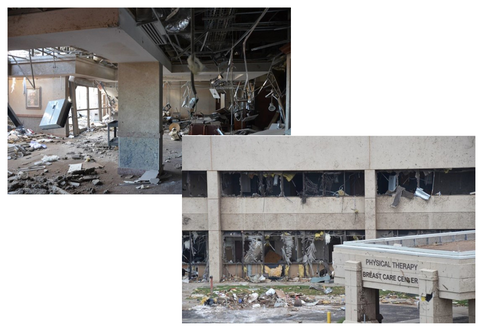Summary
This project will lead to reductions of loss of life and property from tornadoes and improve the resilience of American communities to these powerful storms. This will be accomplished through the development of: a better understanding of tornado hazards; improved building codes, standards and guidance for tornado-resistant design and construction; and better guidance for planning, design and operation of community tornado shelters.
Description

Objective
To advance tornado hazard mitigation through improved characterization of tornadoes and their interaction with buildings and structures, providing the technical foundation for improvements to tornado load design guidelines, standards, codes, and code adoptions. This includes research and development to a) implement the remaining recommendations from the NIST Investigation of the 2011 Joplin Tornado, and b) advance the understanding of tornado hazards and tornado-structure interaction.
Technical Idea
Significant progress has been made on the implementation of a number of the recommendations from the Joplin Tornado investigation final report (see Impacts section below). The project includes a focus on completing the implementation of several remaining recommendations, including:
- Standardization and improvement of the Enhanced Fujita (EF) Scale method for estimating tornado wind speeds
- Development of tornado-resistant design guidance for residential and other building types
- Development of tools to help support the adoption of the 2024 International Building Code (IBC) tornado load requirements by local authorities having jurisdiction, and
- Development of guidelines for selection of best available tornado refuge areas in existing buildings; and development of guidelines that enable communities to create safe and effective public sheltering strategies.
Additionally, recent advances in experimental and numerical simulation of tornadoes and tornado interaction with buildings are providing new tools for tornado hazard characterization and estimation of tornado-induced pressures on buildings. These tools will be used to improve the current tornado load methodology, which will then be proposed for incorporation into future editions of model building codes and standards.
Research Plan
The EF Scale methodology will be improved by establishing a more scientific and quantifiable approach to developing Degree of Damage (DoD) wind speed estimates for existing and new Damage Indicators (DIs). This methodology will be incorporated into a new standard for Wind Speed Estimation in Tornadoes and Other Windstorms currently under development by the American Society of Civil Engineers (ASCE) in cooperation with the American Meteorological Society (AMS).
Additional guidance for tornado-resistant design of residential construction and other building types not already covered by the 2024 IBC, including warehouses, will be developed in collaboration with the NIST Office of Applied Economics and FEMA, incorporating lessons from post-tornado damage assessments and benefit-cost analyses. A national database and user-friendly web map interface documenting tornado strikes on critical facilities will be developed to aid regional and local stakeholders and authorities having jurisdiction in understanding their tornado risk to enable more informed decisions on adoption of building code requirements for tornado shelters and tornado loads on conventional buildings.
Guidelines for identification of best available tornado refuge areas within existing buildings will be developed in collaboration with FEMA by adapting and expanding the damage modeling conducted as part of the tornado hazard map development to create a fragility-based methodology and tool. A series of workshops to identify opportunities, challenges, and best practices associated with the design and operation of public tornado shelters will be conducted in collaboration with FEMA, NOAA, and other stakeholders. Information obtained from the workshops will support development of guidelines enabling communities to create safe and effective public tornado sheltering strategies.
An analysis of the current ASCE 7 tornado pressure coefficients based on comparisons with new tornado simulator data will be conducted to validate and improve the existing provisions, and to fill gaps in their coverage of certain building elements. The performance of warehouses and box-type structures during tornadoes will be assessed through field studies, analysis of aerial and terrestrial imagery, and mining of historical records. This will support the development of design guidance and expansion of the Tornado Strikes on Critical Facilities Database to include warehouses. With the increasing use of uncrewed aircraft systems (i.e., drones) for meteorological measurements, a drone-mounted probe designed to measure horizontal and vertical winds inside of a tornado will be designed and tested at NIST, in a collaborative effort between the Engineering Laboratory and the Physical Measurements Laboratory.
Major Accomplishments
- Developed a new research-based methodology for estimating tornado loads on buildings and other structures, including first-ever probabilistic tornado hazard maps that include the significant effects of building size on tornado risk.
- Filled a major gap in building codes and standards hazard coverage with the first requirements for consideration of tornado loads in the ASCE 7-22 Standard for Minimum Design Loads and the 2024 International Building Code.
- A design guide for these new tornado load provisions was developed in collaboration with FEMA, along with guidance for tornado-resistant residential construction for both new and retrofit applications.
- Led development of multiple editions and significant revisions to the International Code Council’s ICC 500 Standard for Design and Construction of Storm Shelters, including incorporation of the new methodology for determination of tornado loads.
- Model building code requirements for the installation of tornado shelters in new schools and emergency response facilities in the most tornado-prone parts of the United States.
- Guidance on emergency alerts and warning messages has been developed and incorporated into the National Fire Protection Association’s NFPA 1600 and 1616 Standards on emergency management and mass evacuations and sheltering. The NFPA 1616 Standard also incorporated NIST-developed guidance for consideration of building safety in selection of facilities to use as shelters and best available refuge areas for tornadoes and other natural hazards.

